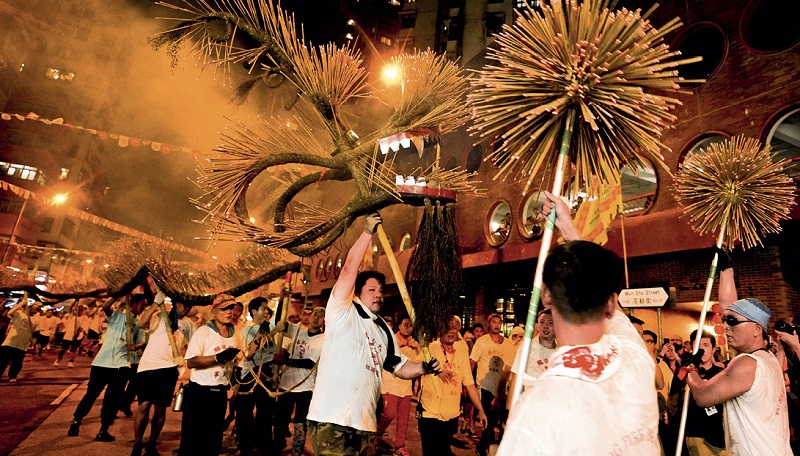
On the eve of the Mid-Autumn Festival, Hong Kong’s traditional Mid-Autumn folk event “Tai Hang Fire Dragon Dance” is staged in Tai Hang, on September 12, 2019.
One of Hong Kong’s modern-looking neighborhoods in Wan Chai District is home to the Tai Hang Fire Dragon Dance, a folk art form with a history of over 100 years. Many years ago, this neighborhood was a village populated by a subgroup of the Han Chinese people named the Hakka, who live mainly in the provinces of Guangdong, Jiangxi, and Fujian in China and speak the Hakka language. It is said that ever since a plague swept through the village, the villagers started to perform a fire dragon dance for three days around the Mid-Autumn Festival in the eighth month of the lunar calendar every year to pray for peace. This later evolved into a festive event in Hong Kong. This tradition was included in the National Intangible Cultural Heritage List in 2011.
For the old generations, fire dragon dancing was the most anticipated event during their growing up years in the village: women busied themselves cutting grass for workers to make the dragon, strong men performed the dance, and children mimicked the fire dragon dancer behind the parade.
The dragon’s bone structure is made of bamboo, rattan, and hemp rope. Its frame consists of several parts including the body, the head, the tail, the eyes, and the ball that the dragon plays with. The dragon bones are wrapped with pearl grass, and it takes 17 or 18 people two or three weeks to complete making it. Thin leaves are used to make the dragon’s head and tail, while the thick ones are used for the dragon body. The most labor-intensive part of the making process is the dragon’s head. When making it, one must work slow and steady, without being rushed. The dragon’s nose should be high, the mouth round, and the horns stretch outward in order to show its majesty.
The Fire Dragon Dance is staged during the 14th, 15th, and 16th nights of the eighth lunar month and lasts about two hours each night. Before each performance begins, actors insert a number of lighted incense sticks into the layer of grass that covers the dragon until a “fire” dragon appears. The dragon is more than 70 meters long and weighs more than 200 pounds, and it takes a team of 200 people working in rotation to perform the dance. It is a very tiring work especially for the dancers who hold the head because the dragon head weighs more than 30 kilos and only one person can hold it during a performance.
Those lighted sticks of incense look like burning scales and liven up the festive night sky, being accompanied by the beats of drums and gongs. Dozens of performers moving the dragon smoothly up and down through the air attract rounds of cheers and applause from surrounding crowds.
In order to further promote the fire dragon culture, the inheritors of the Tai Hang Fire Dragon Dance often give lectures on the history and culture of the dance. They set up fire dragon workshops to demonstrate various aspects of the traditional art from the making techniques to dance skills. In June, 2022, the Hong Kong Tai Hang Fire Dragon Museum was officially opened to inspire more people to learn more about this traditional dance culture.